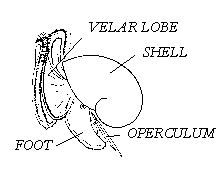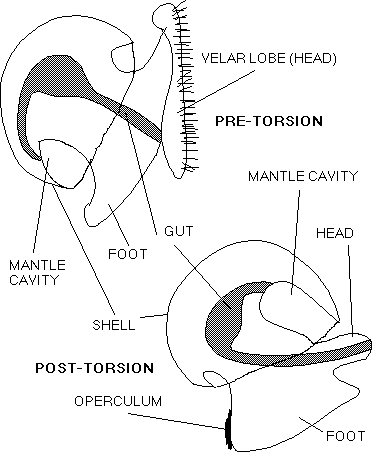| MadSci Network: Zoology |
Thanks for your question, Matthew.
A lot of people seem to have asked similar questions on other "ask a scientist" sites (e.g. the Oceanlink pages), and there is very little information available online, so I'll try to provide a thorough answer....
Sea snails show quite a wide variation in life cycles. The primitive mollusc life cycle (not seen in snails, which scientists call GASTROPODS) has 3 main stages. The eggs hatch into a tiny, swimming larva called a TROCHOPOHORE, which swims and eats using thousands of tiny hairs called cilia. In most snails (a few very primitive ones still have the trochophore stage, which then grows into a veliger) the eggs hatch directly into a second type of swimming larva, which is larger and more complex, called a VELIGER. These have a thin shell with an operculum (a plate which covers the opening of the shell), a muscular foot (like adult snails), and two ciliated wing-like structures (called VELAR LOBES) either side of the head for swimming and feeding. These kinds of larvae may only stay briefly in the plankton, or may stay as plnakton for up to several months. Other snails have veligers which do not feed, but really on yolk provided by the parent. I've provided a simple diagram of a gastropod veliger:

A very important event in a snails life occurs when it is a veliger type of larva,ususally shortly before settling and growing to be a n adult snail. The body and shell of the veliger twist through 180 degrees relative to the foot and head. This is thought to have evolved to allow the operculum to be the last part of the body pulled into the shell, allowing the whole body to be protected. Here is a simple diagram of a veliger before and after torsion:

This theory of torsion was first described by the great (if rather eccentric) zoologist Walter Garstang in 1928, he presented the theory in the form of a verse called "The Ballad of the Veliger or How the Gastropod Got Its Twist".
All land snails and some sea snails have direct development, with both the trochophore and veliger stages being passed inside the egg, and the young being born as mini-adults crawling out of the adult shell. In some the young are cannabilistic inside the parental shell, and only one individual baby emerges!
Swimming larvae are very important for most bottom living sea creatures, because it menas that individuals found on one shoreline can spread to new areas quickly and distinct populations are effectively in contact because the offspring of adults living in one area spread over a large distance as larva and when they settle on the bottom live in a very different area to their parents.
Most gastropods have a small eye at the base of each tentacle, but in some the eyes are enlarged and on stalks. Primitve snails have eyes consisting of a hollow lined with cells that are sensitive to light, this woudl not allow them to see very well but woudl allow them to detect large objects and light sources. More advanced snails have a cornea and lens, which would allow image formation, but can't focus in the same way as vertebrate eyes, becuase the shape and position of the lens cannot be changed, and there is no iris (the part of the eye that narrows and widens when its dark or light).
Try the links in the MadSci Library for more information on Zoology.